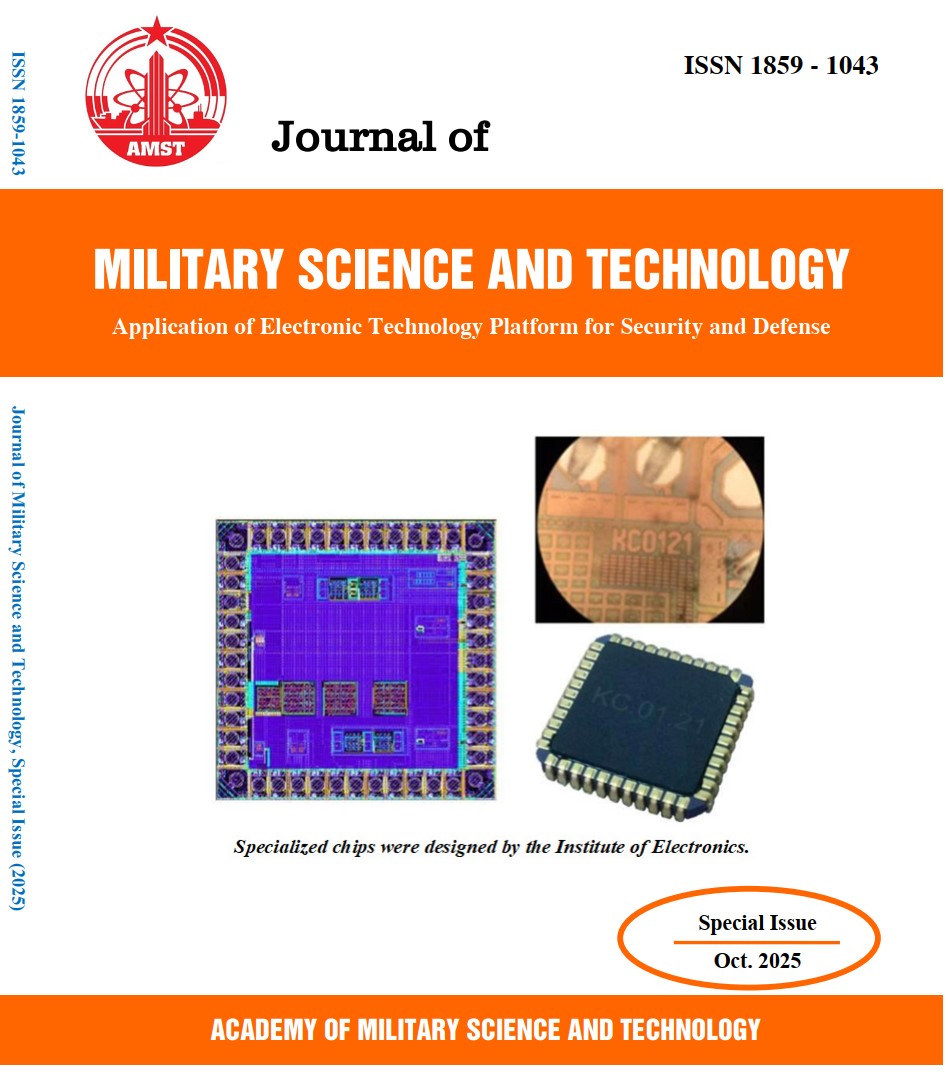A solution for preprocessing to select discrete spectral features of propeller-equipped marine targets to enhance passive acoustic direction-finding accuracy
205 viewsDOI:
https://doi.org/10.54939/1859-1043.j.mst.IITE.2025.139-147Keywords:
Underwater; Passive sonar; Direction of arrival (DOA); Marine target; Propeller.Abstract
The low-frequency discrete spectral components generated by the propeller system of marine targets play a crucial role in signal processing, particularly in the problem of underwater acoustic direction finding. The preprocessing step to select these spectral components helps enhance the signal-to-noise ratio (SNR) of the signal input to direction of arrival (DOA) algorithms. This paper proposes a novel solution to improve the selectivity and accumulation of low-frequency line spectral components, which are key features in the detection and parameter estimation of underwater targets. The proposed method combines several classical signal processing techniques, including low-frequency analysis and recording (LOFAR), detection of envelope modulation on noise (DEMON), and adaptive recursive comb filtering (AR-COMB). This combination enhances the input signal's SNR, providing improved quality for subsequent processing stages, especially DOA estimation. Simulation results demonstrate a significant improvement in the accuracy of the DOA algorithm, suggesting a new approach for detecting and characterizing this type of underwater target.
References
[1]. Naval Engineering Institute, “Research on the Impact of Marine Environmental Factors on the Operating Range of Underwater Acoustic Devices,” National-level Project, Code No. KC.09/11-15 (2015).
[2]. Naval Engineering Institute, “Research on the Design and Development of an Underwater Unmanned Vehicle for Training,” Ministry of National Defense-level Project, Code No. KC.NQ-09 (2021).
[3]. Chen, Z., G. Gokeda, and Y. Yu, Introduction to Direction-of-Arrival Estimation, Artech House (2010).
[4]. Xu, X., X. Wei, and Z. Ye, “DOA Estimation Based on Sparse Signal Recovery Utilizing Weighted l_1-Norm Penalty,” IEEE Signal Processing Letters, Vol. 19, No. 3, pp. 155–158 (2012). DOI: https://doi.org/10.1109/LSP.2012.2183592
[5]. Urick, R. J., Principles of Underwater Sound, 3rd ed., Peninsula Publishing (2013).
[6]. Ali Khan, N. A., Sadiq, J., and Magnus Jansson, “Direction of Arrival Estimation Using Adaptive Directional Time-Frequency Distributions,” Signal Processing, Multidimensional Systems, Vol. 29, No. 2, pp. 503–521 (2018). DOI: https://doi.org/10.1007/s11045-016-0435-y
[7]. Yang, Z., et al., “Sparse Methods for Direction-of-Arrival Estimation,” in Academic Press Library in Signal Processing, Volume 7, Elsevier, pp. 509–581 (2018). DOI: https://doi.org/10.1016/B978-0-12-811887-0.00011-0
[8]. Abraham, D. A., “Underwater Acoustic Signal Processing: Modeling, Detection, and Estimation”, Springer (2019). DOI: https://doi.org/10.1007/978-3-319-92983-5
[9]. Doan, V.-S., et al., “Convolutional Neural Network-Based DOA Estimation Using Non-Uniform Linear Array for Multipath Channels,” in Industrial Networks and Intelligent Systems: 6th EAI International Conference (INISCOM 2020), Hanoi, Vietnam, August 27–28 (2020), Springer. DOI: https://doi.org/10.1007/978-3-030-63083-6_4
[10]. Doan, V.-S., et al., “MoDANet: Multi-Task Deep Network for Joint Automatic Modulation Classification and Direction of Arrival Estimation,” IEEE Communications Letters, Vol. 26, No. 2, pp. 335–339 (2021). DOI: https://doi.org/10.1109/LCOMM.2021.3132018
[11]. Eranti, P. K. and B. D. Barkana, “An Overview of Direction-of-Arrival Estimation Methods Using Adaptive Directional Time-Frequency Distributions,” Electronics, Vol. 11, No. 9, Article 1321 (2022). DOI: https://doi.org/10.3390/electronics11091321
[12]. Li, L., S. Song, and X. Feng, “Combined LOFAR and DEMON Spectrums for Simultaneous Underwater Acoustic Object Counting and f₀ Estimation,” Journal of Marine Science and Engineering, Vol. 10, No. 10, Article 1565 (2022). DOI: https://doi.org/10.3390/jmse10101565
[13]. Mahafza, B. R., “Radar Systems Analysis and Design Using MATLAB”, 4th ed., Chapman and Hall/CRC (2022). DOI: https://doi.org/10.1201/9781003051282
[14]. Болгов, В. М., “Акустические шумы и помехи на судах”, Судостроение (1984).
[15]. Van Son Nguyen, Thanh Chinh Nguyen, Ngoc Dong Nguyen, “A Novel Direction Finding Algorithm Applying to Underwater Passive Sonar System Based on Sparse Representation Combined Adaptive Comb Filter,” ICISN2024 - The 4th International Conference on Intelligent Systems & Networks, Hanoi (03/2024). DOI: 10.1007/978-981-97-5504-2_45. DOI: https://doi.org/10.1007/978-981-97-5504-2_45
[16]. Thanh Chinh Nguyen, Ngoc Dong Nguyen, Khac Hoan Pham, “Direction of Arrival Estimation Based on Smooth MUSIC Algorithm Combined Spectrum Selection Techniques of Noise Characteristics of Marine Targets Equipped with Propeller,” Section on Information and Communication Technology, Vol. 13, No. 01, Le Quy Don Technical University (2024). DOI: 10.56651/lqdtu.jst.v13.n1.816.ict. DOI: https://doi.org/10.56651/lqdtu.jst.v13.n01.816.ict
[17]. Nguyen Thanh Chinh, Nguyen Ngoc Dong, Pham Khac Hoan, Nguyen Duc Minh, “Đề Xuất Giải Pháp Nâng Cao Chất Lượng Định Hướng Trên Cơ Sở Biểu Diễn Không Gian-Thời Gian-Tần Số Tín Hiệu Dùng Cho Các Hệ Thống Sonar Thụ Động,” Journal of Science & Technology Information and Communications, Posts and Telecommunications Institute of Technology, (CS.01) No. 01, pp. 72–79 (2024) (in Vietnamese).







